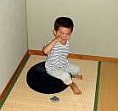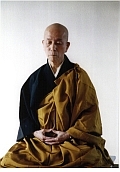
Answers to questions I was asked about zazen.
Q: Is there a difference between choosing to sit
in full-lotus
posture,
half-lotus posture, Burmese style posture or Seiza
posture?
A: The half-lotus or full-lotus posture are generally
regarded as the traditional styles for Zazen. When
someone first starts to do Zazen, it's easier to sit
in the half-lotus posture. After practicing in the
half-lotus posture for a few months or years our leg
muscles become looser and we can try sitting in
full-lotus, even for just a few minutes. The main
difference between the half-lotus posture and the
full-lotus posture is that both knees firmly touch the
ground in the full-lotus, which makes the posture more
stable. Full-lotus is the traditional posture that was
practiced by Gautama Buddha in India long ago.
I donft have much experience with the Burmese style
posture, but it's probably a good posture for anyone
who finds the half-lotus or full-lotus posture
difficult. After getting used to the Burmese style, it
might be good to try the half-lotus or full-lotus
posture. I've never sat in the Seiza posture during
Zazen. The only experience I have of sitting in the
Seiza posture for a long time was at a Japanese tea
ceremony I went to once. I had to sit in the Seiza
posture without a cushion for about 30 or 40 minutes.
It cut off the blood circulation to my legs and I
could hardly stand afterwards, which was a bit
embarrassing until I noticed most of the other people
could hardly stand either. It was kind of funny. Using
a cushion or some kind of bench with the Seiza posture
should make it easier though.
When I first started doing Zazen my legs used to be
really stiff and it was hard for me to sit in any kind
of posture. All I could manage was to sit cross-legged
with my knees way up off the floor. After a while I
started to sit in a kind of gquarter-lotus postureh
with one foot on the calf of the other. After doing
that for a while I managed to sit in half-lotus. After
a while I could sit in the half-lotus posture fairly
comfortably, sometimes with me left foot on my right
leg and sometimes the other way round. A few years
later I started doing full-lotus for a few minutes at
a time. I gradually increased the time that I sat in
full lotus for as my legs got used to doing it.
Nowadays I sit in either the half-lotus or full-lotus
posture.
Q: I have a question regarding concentration
during Zazen. I know Nishijima talks about balancing
our nervous system through maintaining an upright
spine during Zazen. I suppose attempting to pay
attention to the spine is a form of concentration. I
get confused. Most other sects of Buddhism teach you
to follow the breath. I suppose because it happens
every moment and in increments, it makes it easy to
build concentration. What are your thoughts? I
really have a sense that what Nishijima teaches is
the gtrueh teaching, but I have this nagging feeling
that I need to be developing my ability to focus. I
get bombarded with MRI imaging studies of
meditationfs transformative effects on the brain. It
really makes the little "me" want to go for that
stuff.
A: Nishijimafs idea about paying attention to the
spine in Zazen is that when we find ourselves thinking
about something we should straighten our spine and
start to look at the wall again. That can happen often
in one sitting. So when you notice yourself thinking
about or considering something while youfre doing
Zazen, just straighten your spine and look at the
wall. More than likely youfll start thinking about
something again. But when you notice yourself thinking
again, just straighten your spine again. We usually
end up repeating that several times during Zazen, but
there can be times during Zazen when our thinking is
not so active and we are just sitting there without
much mental activity.
When I first sit down to do Zazen Ifm usually
thinking or considering various things. After a while
I notice Ifm thinking so I straighten my spine and
focus on the wall. During Zazen my thoughts tend to
come and go, but I try to avoid latching on to them or
examining them. Sometimes I do though, and when I
notice Ifm doing that, I try to drop whatever it is
Ifm thinking about and straighten my spine. Sometimes
near the end of Zazen I notice my thoughts have slowed
down. Nishijimafs idea is that just doing Zazen helps
our thinking to slow down naturally. And when wefre
sitting without thinking too much, we can notice wefre
just doing a simple action of sitting.
I know what you mean about getting confused by
different ideas people have about meditation.
Following your breath may be helpful when you first
start, but if you continue for a while you might feel
like itfs not necessary anymore. To be honest, Ifve
never really done Zazen that way so I donft know for
sure. For what itfs worth, my idea on counting
breathes is that it's like wefre giving our brain a
task to do during Zazen, and Ifm not sure if that's
really what Zazen is about. Sometimes when I hear
about stuff like counting breathes, I think about
Gautama Buddha in India sitting under the bodhi tree.
I know itfs a kind of silly example, but I guess he
was just sitting there without counting or following
his breath.
About developing your ability to focus, I think it
may be okay to let go of that idea and just to sit
there. That way your ability to focus can develop in a
more natural way than in a particular way you might
have in mind. Of course, to just let it develop
naturally like that we kind of need to trust Zazen a
bit. Itfs a different approach to the one in which we
try to make something happen in Zazen. But it can be a
nice approach too.
Things like MRI imaging studies are very important
and provide useful information. But I donft think the
MRI imaging studies and other studies fully describe
what happens in Zazen. Itfs helpful to know the
scientific side of Zazen, but when youfre actually
doing it, it may be best just to sit without worrying
about studies and things too much.
Q: When Nishijima says to look concretely at the
wall and to keep the eyes focused, does he mean on
one spot?
A: I don't think Nishijima means to keep the eyes
focused on just one spot, but more like let your eyes
settle on the wall. Sometimes the particular spot
you're looking at may change or sometimes it may be
the same.
Q: If Zazen is "enlightenment" itself, then what
happens when we get off the cushion?
A: When we practice Zazen we usually feel a bit
different after we do it. Nishijima call that feeling
the "balanced state". The words "balanced state" sound
a bit flaky, but if you've done Zazen a few times
you'll probably know what he means. Of course, it's
not like that every single time, but that's the
general idea. For example, we might do Zazen in the
morning before we go to work. When we get up off the
cushion that balanced state we feel after doing Zazen
stays with us. When we're gbalancedh like that and our
thoughts don't distract us so much, we can see things
more clearly than we might usually do. But as we go
through the day situations arise that we have to deal
with. Maybe we have a problem with our boss or a
friend or something. A lot of those situations make us
lose our natural balance. So by the end of the day,
our balance is pretty much gone or isnft the same as
it was when we got off the cushion in the morning. So
Nishijima recommends doing Zazen again in the evening
to bring us back to the balanced state.
And Zazen is like any physical exercise. If you do it
regularly, you get used to doing it, and it becomes
easier to keep that balanced state throughout the day,
even when wefre faced with difficult situations. So in
that sense, when wefve been doing Zazen for a number
of years the balance or genlightenmenth may stay with
us after we get off the cushion. But even though the
balance can stay with us for longer when we're not on
the cushion, we still need to do Zazen regularly.




